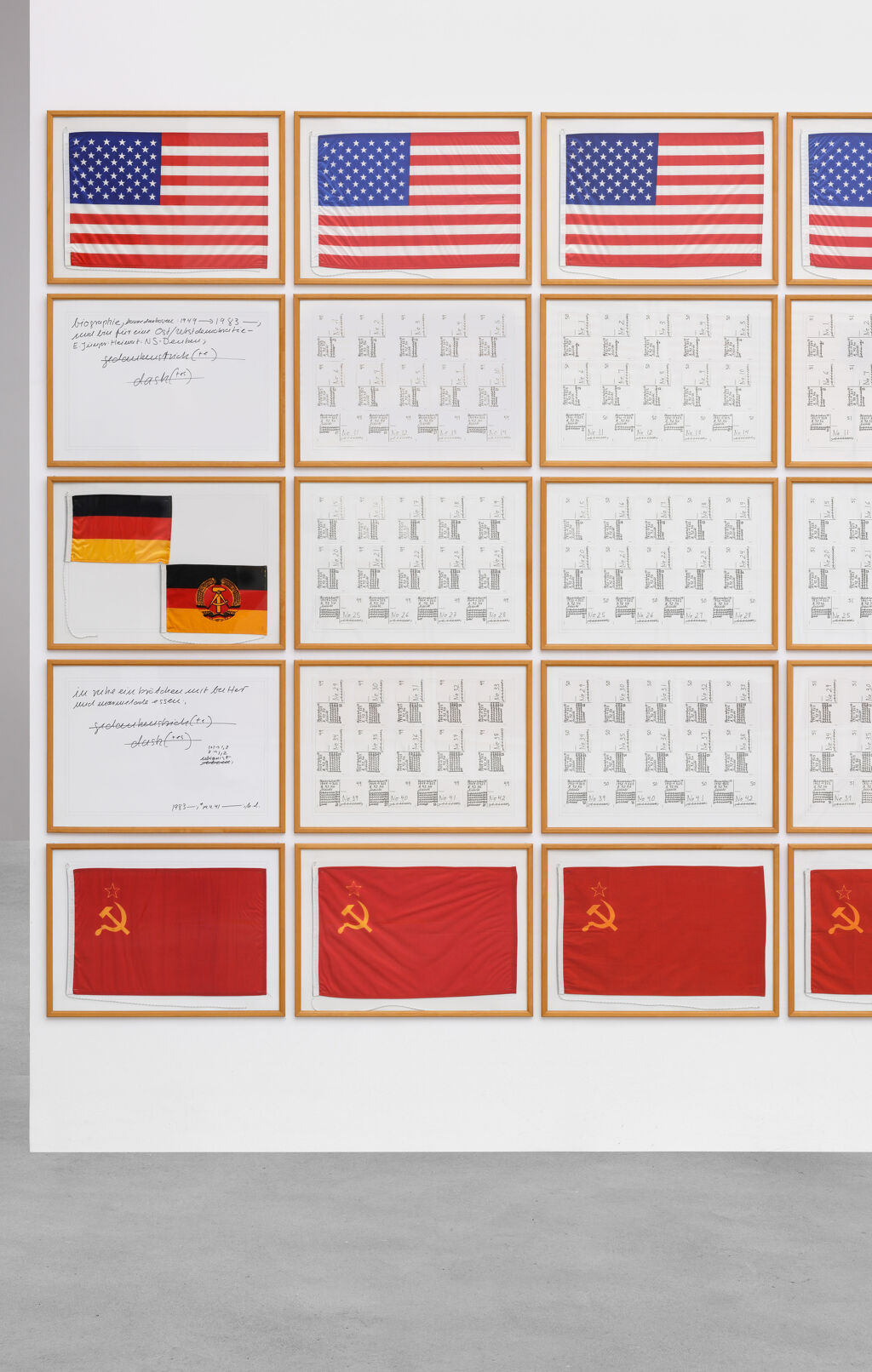Viewing room
Hanne Darboven
Ost-West-Demokratie (1983)

Kewenig is pleased to present Hanne Darboven’s work “Ost-West-Demokratie“ (1983), consisting of 1,512 handwritten postcards, sheets of paper, fabric flags and photographs in 190 frames. This is the fifth exhibition by Hanne Darboven at the gallery, but the first in Berlin.
Hanne Darboven (1941–2009) is one of the most influential women artists of the past decades. Her outstanding work is based on writing, but “writing without describing.” Numbers, being universal and non-literary, were a means of marking out time and space; numbers not as concerned with calculation as with counting. Various of her artworks incorporate a vast collection of texts and visual material representing the history of the 19th and 20th centuries.
Darboven was very reflective about current political affairs. When leaving Hamburg for New York in 1966, she started taking short calendar notes of the most important daily events - political or personal - which were later included into her work. Staying in New York for two years, she came into contact with the leading artists of the then-emerging Conceptual and Minimal Art movements, including especially Sol LeWitt and Carl Andre. It was also during this time that she began her series of "Constructions", the basic, systematic structure of which would set the tone for her entire oeuvre. In key works such as “Schreibzeit“ (1975-1999), “Kulturgeschichte“ or her first historic work “Bismarckzeit“ (1978) Darboven has followed the course of time both in terms of calendar and content, oriented to the events of a certain period of time and focused on issues of contemporary history.
“Ost-West-Demokratie“ (1983) addresses the topic of the Cold War in the upper and bottom row, where framed flags of the USA and the Soviet Union oppose each other, as well as in the introductory column where smaller flags of the GDR and the FRG are framed together. This theme of contemporary history is connected with various biographical aspects of the artist’s life: Darboven’s birthday on April 29th, 1941, photographs and other personal notes like “in ruhe ein brötchen mit butter und marmelade essen“ (EN: “to eat a bread roll with butter and jam in peace“) or “als ich schon schreiben konnte“ (EN: “when I was already able to write“) appear in the outermost columns on the left and right of the work. Ernst Jünger’s name is mentioned together with the words “Heimat“ and “NS-Denken“ - a reference to the scandal caused by the awarding of the Goethe Prize to the controversial writer in 1982.
Exhibition view, Hanne Darboven "Zeitgeschichten", Bundeskunsthalle, Bonn, 2015
In the middle section, consisting of 36 columns and 3 rows, Darboven visualizes the passing of time between 1949 - the founding year of two separate German states - and 1983 - the year of the creation of the work. By numbering this span of years on postcards she creates a calendar structured in days, months and years. Each column represents one year which is mirrored in 42 postcards, each containing one of 42 possible cross-sums that can be counted from 365 or 366 different days of a year. This cross-sum system was developed by Darboven in the early 1970s and employed ever since to make the phenomenon of time visually tangible.
“I only use numbers because it is a way of writing without describing... It has nothing to do with mathematics. Nothing! I choose numbers because they are so constant, confined, and artistic. Numbers are probably the only real discovery of mankind.”
- Hanne DarbovenIn this work, the number 42 is charged with another symbolic meaning: in 1983, when she created “Ost-West-Demokratie“, Hanne Darboven was 42 years old. The inscription “biographie, hanne darboven 1949->1983“ referring to her lifetime, the work intertwines personal and political history.
The year of 1983, was one of the most sensitive phases of the Cold War and the convergence of these superpowers and the two German states was just a vague hope, articulated by Darboven not only in the words “ich bin für eine Ost-West-Demokratie“ (EN: “I am for an East-West-Democracy“) but also through the outstanding symbolic power of this installation. In today's world, with democracy being under threat in many places, the appeal in this unique work of Darboven's takes on renewed importance.
In 1969 Hanne Darboven was included in Harald Szeemann’s legendary exhibition ‚‘Live in Your Head - When Attitudes Become Form’ at Kunsthalle Bern and she took part in several editions of the documenta, Kassel. Her work was honored internationally in solo exhibitions held by renowned museums and institutions, such as the Museet for samtidskunst, Oslo (2000); the Museum Moderner Kunst, Stiftung Ludwig, Vienna, and Haus Konstruktiv, Zurich (2003); the Museo Nacional Reina Sofia, Madrid (2014); the Bundeskunsthalle, Bonn, and Haus der Kunst, Munich (2015); the Dia Center for the Arts, New York (1996, 2016) and most recently at MKM - Museum Küppersmühle für Moderne Kunst, Duisburg (2020).
Darboven’s work is part of renowned public collections such as the ones of the Kunstsammlung des Deutschen Bundestages, Berlin; Hamburger Bahnhof - Museum für Gegenwart, Berlin; the Museum für Moderne Kunst MMK, Frankfurt; Sammlung Falckenberg, Hamburg; Hamburger Kunsthalle, Hamburg; Tate, London; Museum of Contemporary Art, Los Angeles; Museum of Modern Art, New York; the Dia Art Foundation, New York; the Solomon R. Guggenheim Foundation, New York; National Museum of Art, Architecture and Design, Oslo; the Centre Pompidou, Paris; the San Francisco Museum of Modern Art, San Francisco; National Museum of Modern Art Tokyo; or the Migros Museum für Gegenwartskunst, Zurich, amongst many others. Hanne Darboven’s estate is executed by the Hanne Darboven Foundation, Hamburg, which the artist established herself in the year of 2000.
Works
For more information about this work, please email gallery@kewenig.com.